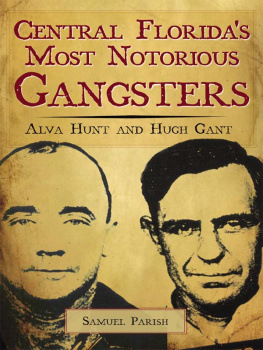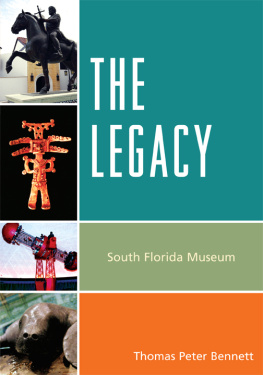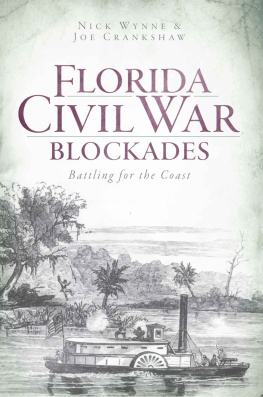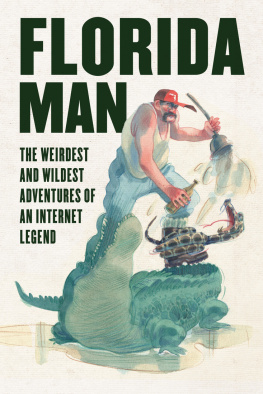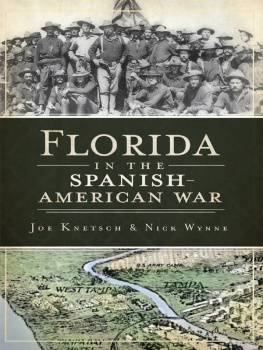

Published by The History Press
Charleston, SC 29403
www.historypress.net
Copyright 2008 by Samuel Parish
All rights reserved
Unless otherwise credited, all images are from the collection of the author.
First published 2008
e-book edtion 2012
ISBN 978.1.61423.481.4
Library of Congress Cataloging-in-Publication Data
Parish, Samuel.
Central Floridas most notorious gangsters : Alva Hunt and Hugh Gant / Samuel Parish.
p. cm.
Includes bibliographical references.
print ISBN-13: 978-1-59629-414-1 (alk. paper)
1. Hunt, Alva Dewey. 2. Gant, Hugh Archer, b. 1900. 3. Gangsters--Florida--Biography. 4. Organized crime--Florida--Biography. I. Hunt, Alva Dewey. II. Gant, Hugh Archer, b. 1900. III. Title.
HV6785.P37 2007
364.10922759--dc22
[B]
2007044280
Notice: The information in this book is true and complete to the best of our knowledge. It is offered without guarantee on the part of the author or The History Press. The author and The History Press disclaim all liability in connection with the use of this book.
All rights reserved. No part of this book may be reproduced or transmitted in any form whatsoever without prior written permission from the publisher except in the case of brief quotations embodied in critical articles and reviews.
Contents
Overview
Sumter County produced two gangsters who fit into the Roaring Twenties criminal pantheon with Al Capone, Pretty Boy Floyd, the Barkers, John Dillinger and Bonnie and Clyde Barrow. There were, however, significant differences between Sumter County, Floridas gangsters and those of the Midwest corridor of crime.
While most of the criminals of the late 1920s and 1930s centered their activities in the American Midwest, from where most of them hailed, Alva Dewey Hunt and Hugh Archer Gant focused mostly on their home state of Florida. More precisely they focused on Florida using Sumter and surrounding counties as their headquarters. Additionally, unlike those well-known gangsters Hunt and Gant resorted to less violence and never killed anyone during the commission of a crime.
Gant was a lifelong resident of Sumter County. Fittingly he lived in an area near Webster called Gant Lake, settled by his ancestors during the countys founding. Hunt probably moved to Sumter County with his family at a very young age, settling in Bushnell, where H.D. Hunt, the family patriarch, became an active and successful member of the community.
Gant and Hunt were united by common threads. The most direct was Hunts early marriage to Gants sister, Katherine. Both young men were also enthusiasts of the recently popularized automobile with Hunt being the more mechanically inclined. Finally, and probably most importantly, was the link that ran throughout the state of Florida and the rest of the countrythe Great Depression. Many causes for the rise in Depression-era criminality have been offered. Weakened economic conditions, escalating farm foreclosures and a general despair guided men toward criminal pursuits, men who otherwise might not have been drawn into them.
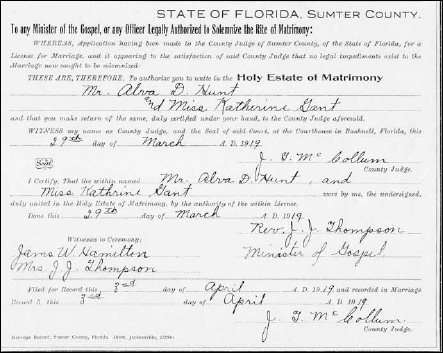
Evidence of the marriage that united Hunt and Gant into a Depression-era crime family.
Both served in World War I and returned changed. What they saw during their service probably had a profound impact on them, and like many who survived the experience, they may have internalized negative aspects of violence. Yet despite all these projections, there is no solid evidence to suggest why Hunt and Gant got into crime, but timing certainly factored into their decision. They matured into their early twenties as the roar of the 1920s lessened to a whisper and then faded away.
Although 1929 marked a peak of prosperity in the United States, four years later the Depression had reached its low point. According to Robert McElvaines The Great Depression, unemployment skyrocketed from just over 3 percent to nearly one-quarter of the working population. A lack of opportunity may have played a role in Hunt and Gants choice of vocation. The obvious choice of farming was prohibitive because land was not easy to acquire and conditions were particularly bad for farmers, who were now in the second decade of their depression in Florida.
Like many others Hunt and Gant began with small steps. The arrest of Gant in Orlando for public intoxication was his first recorded legal problem. At some point soon after both boys moved into an automobile fencing operation, taking stolen parts for rework and illegal sale, for which they were arrested once in Sumter County. They progressed from fencing when they began to physically steal and alter automobiles for resale and parts distribution. Presumably they were able to make more money stealing and altering than simply fencing. At one point the Hunt-Gant automobile theft operation was one of the largest and most prolific in the state. Their names became associated with car thefts from the Georgia border south to Miami and from the southwest coast north to Tallahassee. During that reign each was arrested several times. Pardons, legal mistakes, successful appeals and jail escapes freed them to continue car thievery.
A hiatus followed the 1933 store burglary when Gants older brother, and reputed gang leader to that point, was gunned down. Two unidentified cohorts were with Riley Gant and successfully escaped. Hunt and Hugh Gant were probably the two accomplices.
With a background in car thievery and automobile mechanics and the ending of their car theft ring Hunt and Gant stepped up to a new level of crimebank robbery. Their background in auto thievery played a pivotal and prominent role in the gangs escapes after bank heists. They developed a modus operandi that quickly evolved into a successful one. The pattern involved the theft of a vehicle, usually a sedan and typically about two or three weeks before the bank job, and concluded with taking a nearby residence in order to case the bank target. That mode of operation was typical among most successful bank robbery combines. At first they hit small banks and were rewarded with equally small hauls. As they progressed in skill and increased in desires and confidence the takes became more rewarding and the bank jobs more brazen.
Their daytime robbery in Ybor City, a Tampa suburb, resulted in a $26,000 take and fostered a cry that went out across Florida in the press and by word of mouth. Get Gant became the phrase and Hugh Gant became the focus when Florida crimes were brilliantly planned and difficult to solve.
The criminal combine, known as Hunt-Gant during their automobile operation, morphed into the Gant Gang. Several variants followed but what resulted was Gant being perceived as the chief bad man and the gangs leader in title and brashness. In the end, the combine, by any name, was responsible for more than a handful of bank robberies, numerous post office jobs, an assault and robbery-related kidnappings, and according to accusations, a wide array of other crimes. Although they were never convicted for a murder in Kentucky, a robbery of the Seaboard Air Line Railroad company or safe robberies in Atlanta, Georgia, and other points throughout the South, these crimes were attributed to them.
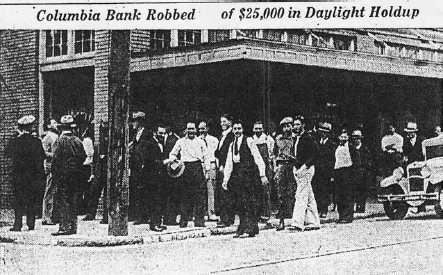
Next page
